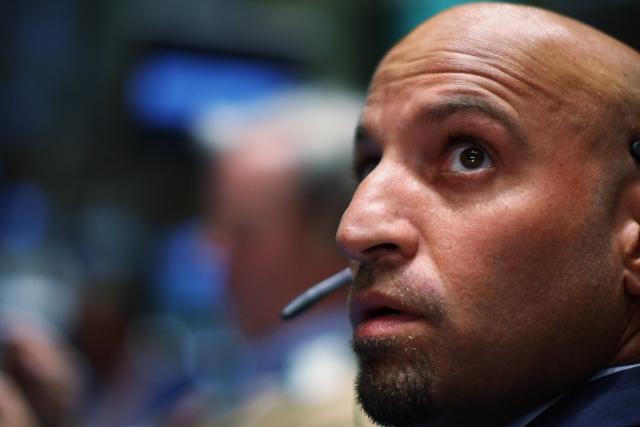Stock Market Crash Definition Examples Protection
Post on: 26 Сентябрь, 2015 No Comment

What Not to Do in a Stock Market Crash
Definition: A stock market crash is whenever the stock market loses more than 10% in a day or two. This differentiates it from a stock market correction. which is usually a loss of 10% or less over many days. You can measure the percentage losses in a stock market crash with any of the major stock market indices: the Dow Jones Industrial Average. the S&P 500 or the NASDAQ .
Crashes are dangerous. They can lead to a bear market. which is an extended stock market decline that typically lasts 18 months. When this happens, a stock market crash can cause a recession .
Recognize the Warning Signs
The market usually crashes after an extended bull market. which is an upswing in stock prices. Greed drives stock prices above the underlying worth of the company, as measured by earnings. Stock prices that aren’t supported by earnings or underlying economic reality is how you can tell when the stock market is about to crash. There’s a feeling of I’ve got to get in now or I’ll miss the profits, which leads to panicked buying. Usually, the individual investor will buy right at the market peak.
The stock market crash is the reverse, panicked selling. That’s when the individual investor, if driven by fear, usually sells. When investors are driven by emotion, not financials, then that emotion can reverse quickly, turning into panicked selling. That’s the symptom of a stock market crash.
What Not to Do
Buying high and selling low is a sure-fire way to lose money in the stock market. That’s why it’s extremely difficult to time the market. By the time you get the information to make a move, institutional investors and traders have moved on.
What’s the solution? Keep a well-diversified portfolio of stocks. bonds and commodities. Rebalance it as market conditions change. During a stock market crash, stocks will make up less of your portfolio, while bonds and commodities will make up more. Sell some of the bonds and commodities to buy more stocks, now that the prices are down. When they go up again — and they always do — you will profit from the upswing in stock prices. You’ve sold some of your bonds and commodities, so you won’t lose as much when those prices fall during the bull market. Even the most sophisticated investor finds it difficult to recognize a stock market crash until it is too late!
Examples
The most famous was the Stock Market Crash of 1929. It kicked off the Great Depression. Over four days, share prices fell 25%. It began on October 24, 1929, now known as Black Thursday. Stock prices fell 11%, then recoverd, as 12.9 million shares of stock were sold, triple the normal amount. Trading on Friday seemed back to normal. However, the market dropped another 13% on Black Monday, despite the bankers’ attempts to stop the panic. The next day, Black Tuesday, the market fell another 11%. The loss of confidence in Wall Street helped kick off the Great Depression. The Dow didn’t regain it pre-crash level until November 23, 1954.
The Flash Crash occurred on May 6, 2010, when the Dow plummeted nearly 1,000 points in just a few minutes. It was a technical malfunction caused by an unexplainable shutdown of high frequency computer trading programs.
The Market Crash of 2008 was signified by the 700 point drop on the Dow on September 29, 2008. This was the largest point drop in the history of the NYSE. That was the day the bailout bill failed in the Senate, prompting widespread panic after the bankruptcy of Lehman Brothers. Between its peak of on and its bottom of on March. the Dow lost more than 50% of its value. It didn’t regain its pre-crash level until
The Dot Com Bubble crashed in March 2000. In 1999, stock prices of high tech and computer companies were driven up by investors who thought all tech companies were guaranteed money makers. They didn’t realize that the huge profits of some of these companies had been driven by the Y2K scare. Companies bought new computer systems to make sure their software would understand the difference between 2000 and 1900. Back in those days, only two date fields were needed, not the four required to differentiate the two centuries. The book Irrational Exuberance became famous because it explained the herd mentality that created the stock tech bubble in 2000. He also predicted the subsequent stock market crash that led to the 2001 recession.
The Asia Financial Crisis occurred on Oct. 27, 1997. The Dow dropped 554.26 points in response to a 6% decline in Hong Kong’s Hang Seng index. The drop in the stock market helped trigger the Long-term Capital Management Crisis .
Black Monday. the crash of 1987, occurred on October 19, 1987. The Dow dropped 20.4%, the largest one-day percentage loss in stock market history. It took two years before the market returned to pre-crash levels. The crash followed a 43% increase earlier that year. It was caused by a combination of factors. First traders were concerned about anti-takeover legislation moving through Congress. Second, foreign investors started selling when the Treasury Security announced he might let the dollar’s value fall. The losses were escalated when they triggered sell orders from computer trading programs. A recession was avoided by aggressive Federal Reserve monetary policy.(Source: Marketwatch, 10 Greatest Market Crashes. October 17, 2012) Article updated April 17, 2014














